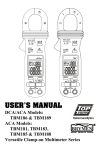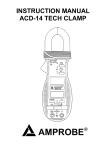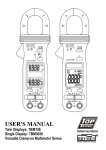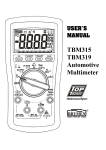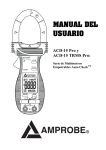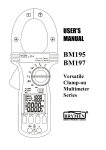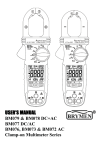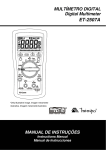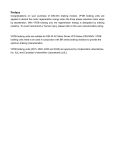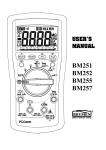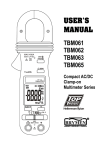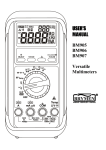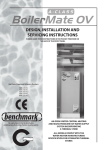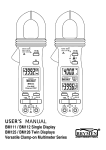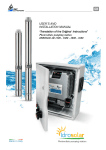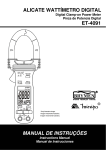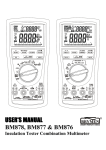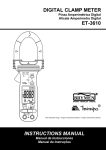Download Temperature function
Transcript
USER'S MANUAL BM181 BM183 BM185 BM188 Versatile Clampon Multimeter Series 1 1) SAFETY This manual contains information and warnings that must be followed for operating the instrument safely and maintaining the instrument in a safe operating condition. If the instrument is used in a manner not specified by the manufacturer, the protection provided by the instrument may be impaired. The meter protection rating, against the users, is double insulation per IEC61010-1 2nd Ed., EN61010-1 2nd Ed., UL61010-1 2nd Ed., CAN/CSA C22.2 No. 61010.10.92, IEC61010-2-032, EN61010-2-032, UL61010B-2-032, & CAN/CSA C22.2 No. 61010-2-032-04: Measurement Category III 600V AC & DC. Per IEC61010-1 2nd Ed. (2001) Measurement Category Measurement Category IV (CAT IV) is for measurements performed at the source of the low-voltage installation. Examples are electricity meters and measurements on primary overcurrent protection devices and ripple control units. Measurement Category III (CAT III) is for measurements performed in the building installation. Examples are measurements on distribution boards, circuit- breakers, wiring, including cables, bus-bars, junction boxes, switches, socket-outlets in the fixed installation, and equipment for industrial use and some other equipment, for example, stationary motors with permanent connection to the fixed installation. Measurement Category II (CAT II) is for measurements performed on circuits directly connected to the low voltage installation. Examples are measurements on household appliances, portable tools and similar equipment. TERMS IN THIS MANUAL WARNING identifies conditions and actions that could result in serious injury or even death to the user. CAUTION identifies conditions and actions that could cause damage or malfunction in the instrument. 2 WARNING To reduce the risk of fire or electric shock, do not expose this product to rain or moisture. The meter is intended only for indoor use. To avoid electrical shock hazard, observe the proper safety precautions when working with voltages above 60 VDC or 30 VAC rms. These voltage levels pose a potential shock hazard to the user. Before and after hazardous voltage measurements, test the voltage function on a known source such as line voltage to determine proper meter functioning. Keep your hands/fingers behind the hand/finger barriers (of the meter and the test leads) that indicate the limits of safe access of the hand-held part during measurement. Inspect test leads, connectors, and probes for damaged insulation or exposed metal before using the instrument. If any defects are found, replace them immediately. Only use the test lead provided with the equipment or UL Listed Probe Assembly. This Clamp-on meter is designed to apply around or remove from uninsulated hazardous live conductors. But still, individual protective equipment must be used if hazardous live parts in the installation where measurement is to be carried out could be accessible. CAUTION Disconnect the test leads from the test points before changing meter functions. INTERNATIONAL ELECTRICAL SYMBOLS ! Caution ! Refer to the explanation in this Manual Caution ! Risk of electric shock Earth (Ground) Double Insulation or Reinforced insulation Fuse AC--Alternating Current DC--Direct Current Application around and removal from hazardous live conductors is permitted 2) CENELEC Directives The instruments conform to CENELEC Low-voltage directive 2006/95/EC and Electromagnetic compatibility directive 2004/108/EC 3 3) PRODUCT DESCRIPTION This user's manual uses only representative model(s) for illustrations. Please refer specification details for function availability to each model. 1) Transformer Clamp Jaw for AC current magnetic field pick up 2) Hand/Finger Barrier to indicate the limits of safe access of the meter during measurement 3) Push-buttons for special functions & features. 4) Input Jack for all functions EXCEPT non-invasive ACA current function 5) Common (Ground reference) Input Jack for all functions EXCEPT non-invasive ACA current function 6) Slide-switch Selector to turn the power ON/OFF and Select a function 7) 3-5/6 digits 6000 counts & 31/2 digits 2000 counts dual numeric LCD display 8) Jaw trigger for opening the transformer clamp jaw 9) Jaw center Indicators, at where best ACA accuracy is specified 10) Jaw marking lines for ACA position error indication 4 4) OPERATION CAUTION: Before and after hazardous voltage measurements, test the voltage function on a known source such as line voltage to determine proper meter functioning. ACV Hz, DCV functions Set slide-switch to Voltage function position(s). Inputs are made through the test leads terminals. For Models 185 & 188, Slide-switch on defaults at ACV Hz Function. Press SELECT button momentarily toggles to DCV function. For Models 181 & 183, ACV Hz & DCV functions are in different slide-switch positions. ACA Hz function Set the slide-switch to select ACA Hz function. Input is made through the clamp jaws for non-invasive current measurements. Note: The Hz trigger level is determined by the ACV or ACA function-range being in use. Press RANGE button to select different function-ranges and thus trigger levels 5 manually. CAUTION (Application and removal of the Clamp-on meter) For non-invasive ACA current measurements, press the jaw trigger and clamp the jaws around only one single conductor of a circuit for load current measurement. Make sure the jaws are completely closed, or else it will introduce measurement errors. Enclosing more than one conductor of a circuit will result in differential current (like identifying leakage current) measurement. Locate the conductor(s) at the Jaws center as much as possible to get the best measuring accuracy. For removal, press the jaw trigger and remove the jaws from the conductor(s). Adjacent current-carrying devices such as transformers, motors and conductor wires will affect measurement accuracy. Keep the jaws away from them as much as possible to minimize influence. 6 Temperature function (Model 185 & 188 only) Set slide-switch to ACA Hz / TEMP functions position. Slide-switch on defaults at ACA Hz Function. Press SELECT button momentarily to select oC (Celsius) function. Press once again to select oF (Fahrenheit) function. Inputs are made through the test leads terminals. Be sure to insert the banana plug type-K temperature bead probe Bkp60 with correct polarities. You can also use a plug adapter Bkb32 (Optional purchase) with banana pins to type-K socket to adapt other type-K standard mini plug temperature probes. DCA Current function (Model 185 & 188 only) Set slide-switch to DCA function position. Inputs are made through the test leads terminals. Application notes: The DCA function is designed especially for HVAC/R flame sensor applications. The 0.1A resolution is useful for identifying the minute current changes in flame detector applications. Flame signal current check should indicate steady flame signal of at least 2A for a rectification type, or 1.5A for an ultraviolet type (8A for self checking systems). If a flame signal current with inadequate strength or fluctuation beyond 10%, check the following to avoid the risk of unwanted flame relay dropout : For gas or oil flames (Minipeeper): Low supply voltage Detector location Defective detector wiring Dirty viewing windows Faulty Minipeeper For oil flames (Photocell): Detector location & wiring Smoky flame or poorly adjusted air shutter Faulty Photocell Temperature over 165 F (74 C) at photocell For gas flames (Flame Rod): Ignition interference (A flame signal current difference with the ignition both on and off greater than 0.5A indicates the presence of ignition interference) Insufficient ground (must be at least 4 times the detector area) Flame lifting off burner head (ground), or not continuously in contact with the flame rod 7 Temperature in excess of 600 oF (316 oC) at the flame electrode insulator causing short to ground. AutoCheckTM mode This innovative AutoCheckTM feature automatically selects measurement function of DCV, VFD-ACV Hz (with low pass filters) or Resistance () based on the input via the test leads. ●With no input, the meter displays “Auto” when it is ready. ●With no voltage signal but a resistance below 10M (nominal) is present, the meter displays the resistance value. When the resistance is below the “Audible Threshold”, the meter further gives a continuity beep tone. ●When a signal above the voltage threshold of 1V DCV or VFD-ACV up to the rated 600V is present, the meter displays the voltage value in appropriate DCV or VFDACV, whichever larger in peak magnitude. Note: *Range-Lock and Function-Lock Feature: When a measurement reading is being displayed in AutoCheckTM mode, press the RANGE or SELECT button momentarily 1 time can lock the range or function it was in. Press the button momentarily 8 repeatedly to step through the ranges or functions. *As Hazardous-Alert: When making resistance measurements in AutoCheckTM mode, an unexpected display of voltage readings alerts you that the object under test is being energized. *Ghost-voltage Buster: Ghost-voltages are unwanted stray signals coupled from adjacent hard signals, which confuse common multimeter voltage measurements. Our AutoCheckTM mode provides low (ramp-up) input impedance (approx. 2.5kΩ at low voltage) to drain ghost voltages leaving mainly hard signal values on meter readings. It is an invaluable feature for precise indication of hard signals, such as distinguishing between hot and open wires (to ground) in electrical installation applications. WARNING: AutoCheckTM mode input impedance increases abruptly from initial 2.5kΩ to a few hundred kΩ’s on high voltage hard signals. “LoZ” displays on the LCD to remind the users of being in such low impedance mode. Peak initial load current, while probing 600VAC for example, can be up to 340mA (600V x 1.414 / 2.5kΩ), decreasing abruptly to approx. 3.4mA (600V x 1.414 / 250kΩ) within a fraction of a second. Do not use AutoCheckTM mode on circuits that could be damaged by such low input impedance. Instead, use slide-switch selector or high input impedance voltage modes to minimize loading for such circuits. 9 While in AutoCheckTM function, press SELECT button momentarily to manually select the low input impedance (LoZ) ACV Hz, VFD ACV Hz and DCV functions as well as the Resistance, Continuity, Capacitance and Diode functions in 10 sequence. Note 1. Both ACV Hz (LoZ) & VFD ACV Hz (LoZ) function selections are equipped with low pass filter to deal with VFD (Variable Frequency Device) signals. VFD ACV Hz (LoZ) selection, however, further pre-selects the most appropriate voltage-ranges and thus the Hz trigger levels to best cope with most VFD-Voltage and VFD-Frequency applications. 2. When using Diode test function, normal forward voltage drop (forward biased) for a good silicon diode is between 0.400V to 0.900V. A reading higher than that indicates a leaky diode (defective). A zero reading indicates a shorted diode (defective). An OL indicates an open diode (defective). Reverse the test leads connections (reverse biased) across the diode. The digital display shows OL if the diode is good. Any other readings indicate the diode is resistive or shorted (defective). CAUTION 1. Using Resistance, Continuity, Diode or Capacitance function in a live circuit will produce false results and may damage the meter. In many cases the suspected component(s) must be disconnected from the circuit to obtain an accurate measurement reading. 2. When using Capacitance function, discharge capacitor(s) before making any measurements. Large value capacitors should be discharged through an appropriate resistance load Electric Field EF-Detection In Voltage, Current or Temperature function, press the EF button for one second or more and release to toggle to EF-Detection feature. The meter displays “E.F.” when it is ready. Signal strength is indicated as a series of bar-graph segments on the display together with variable beep tones. 11 ●Non-Contact EF-Detection: An antenna is located along the top-right end of the clamp jaw, which detects electric field surrounds energized conductors. It is ideal for tracing live wiring connections, locating wiring breakage and to distinguish between live or earth connections. ●Probe-Contact EF-Detection: For more precise indication of live wires, such as distinguishing between live and ground connections, use the Red (+) test probe for direct contact measurements. PC computer interface capabilities The instrument equips with an optical isolated interface port at the meter back for data communication. Press and hold the HOLD button while turning the meter on to enable meter PC-COMM output. Optional purchase PC interface kit BRUA13X is required to connect the meter to the PC computer RS232 or USB ports. 12 Hold The hold feature freezes the display for later view. Press the HOLD button momentarily to toggle the hold feature. 5ms CREST-MAX capture mode Press CREST (HOLD) button for one second or more and release to activate CREST-MAX capture (Instantaneous Peak-Hold) mode to capture signal peak of voltage or current in duration as short as 5ms. The LCD “C” & “MAX” turn on. Press the button momentarily again can toggle the combination use of HOLD feature. Press the button for 1 second or more and release to exit CREST-MAX capture mode. Auto-ranging and Auto-Power-Off are disabled automatically in this mode. Backlighted LCD display (models 185 & 188 only) Press the SELECT button for 1 second or more to toggle the LCD backlight. The backlight will also be turned off automatically after 32 seconds to extend battery life. Relative-Zero ( ) mode Relative-Zero allows the user to offset the meter consecutive measurements with the main display displaying reading as the reference value. Press the REL button momentarily to toggle Relative-Zero mode. Manual or Auto-ranging Press the RANGE button momentarily to select manual-ranging, and the meter will remain in the range it was in, the LCD turns off. Press the button momentarily again to step through the ranges. Press and hold the button for 1 second or more and release to resume auto-ranging. Note: Manual ranging feature is not available in Hz and function ranges. Set Beeper Off Press the RANGE button while turning the meter on to temporarily disable the Beeper feature. Turn the slide switch OFF and then back on to resume. Auto-Power-Off (APO) The Auto-Power-Off (APO) mode turns the meter off automatically to extend battery life after approximately 34 minutes of no rotary switch or push button operations. To wake up the meter from APO, press the SELECT button momentarily or turn the slide switch OFF and then back on. Always turn the slide switch to the OFF position when the meter is not in use 13 Disabling Auto-Power-Off Press and hold the SELECT button while turning the meter on to temporarily disable the Auto-Power-Off (APO) feature. Turn the slide switch OFF and then back on to resume. 5) MAINTENANCE WARNING To avoid electrical shock, disconnect the meter from any circuit, remove the test leads from the input jacks and turn OFF the meter before opening the case. Do not operate with open case. Trouble Shooting If the instrument fails to operate, check batteries and test leads etc., and replace as necessary. Double check operating procedure as described in this user’s manual. If the instrument voltage-resistance input terminal has subjected to high voltage transient (caused by lightning or switching surge to the system under test) by accident or abnormal conditions of operation, the protective impedance components in series might be blown off (become high impedance) like fuses to protect the user and the instrument. Most measuring functions through this terminal will then be open circuit. Such components should then be replaced by qualified technician. Refer to the LIMITED WARRANTY section for obtaining warranty or repairing service. Accuracy and Calibration Accuracy is specified for a period of one year after calibration. Periodic calibration at intervals of one year is recommended to maintain meter accuracy. If self-diagnostic message “C_Er” is being displayed while powering on, some meter ranges might be largely out of specifications. To avoid mis-leading measurements, stop using the meter and send it for re-calibration. Refer to the LIMITED WARRANTY section for obtaining calibration, repairing or warranty service. Cleaning and Storage Periodically wipe the case with a damp cloth and mild detergent; do not use abrasives or solvents. If the meter is not to be used for periods of longer than 60 days, remove the batteries and store them separately. 14 Battery replacement The meter uses standard 1.5V AAA Size (NEDA 24A or IEC LR03) battery X 2 Loosen the 2 captive screws from the battery cover case. Lift the battery cover case. Replace the batteries. Replace battery cover case. Re-fasten the screws. GENERAL SPECIFICATIONS Display: 3-5/6 digits 6000 counts. & 3-1/2 digits 1,999 counts for Hz Polarity: Automatic Update Rate: 5 per second nominal; Operating Temperature: 0C to 40C Relative Humidity: Maximum relative humidity 80% for temperature up to 31C decreasing linearly to 50% relative humidity at 40C Pollution degree: 2 Storage Temperature: -20C to 60C, < 80% R.H. (with battery removed) Altitude: Operating below 2000m Temperature Coefficient: nominal 0.15 x (specified accuracy)/ C @(0C -- 18C or 28C -- 40C), or otherwise specified Sensing: Average sensing for models 181 & 185; True RMS for models 183 & 188 Safety: Double insulation per IEC61010-1 2nd Ed., EN61010-1 2nd Ed., UL61010-1 2nd 15 Ed. & CAN/CSA C22.2 No. 61010.1-0.92 to CAT III 600V and CAT IV 300V AC & DC Transient Protection: 6.0kV (1.2/50s surge) Overload Protections: ACA Clamp-on jaws: AC 600A rms continuous “ + “ & COM Terminals(all other functions): 660VDC/VAC rms E.M.C.: Meets EN61326-1:2006 (EN55022, EN61000-3-2, EN61000-3-3, EN61000-4-2, EN61000-4-3, EN61000-4-4, , EN61000-4-5, EN61000-4-6, EN61000-4-8, EN61000-411) In an RF field of 3V/m: Capacitance function is not specified Other function ranges: Total Accuracy = Specified Accuracy + 100 digits Performance above 3V/m is not specified Power Supply: 1.5V AAA Size battery X 2 Power Consumption: 5.2mA typical Low Battery: Below approx. 2.4V APO Timing: Idle for 34 minutes APO Consumption: 10A typical Dimension: L190mm X W63mm X H32mm Weight: 179 gm Accessories: Test leads (pair), user's manual, Bkp60 banana plug K-type thermocouple x 1 (Models 185 & 188 only) Optional purchase accessories: USB interface kit BRUA-13X; BKB32 banana plug to type-K socket plug adaptor (Models 185 & 188 only) Special Features: AutoCheckTM V&; VFD-V & VFD-Hz; Backlighted LCD (185 & 188 only); 5ms CREST-MAX Capture mode (Peak Hold); Auto-ranging Relative-Zero mode; Display Hold; EF-Detection (NCV); Interface capabilities with PC computers Electrical Specifications Accuracy is (% reading digits + number of digits) or otherwise specified, at 23C 5C & less than 75% relative humidity. True RMS models 183 & 188 voltage accuracies are specified from 5 % to 100 % of range or otherwise specified. Maximum Crest Factor <1.65:1 at full scale & < 3.3:1 at half scale, and with frequency components within the specified frequency bandwidth for nonsinusoidal waveforms. DC Voltage RANGE Accuracy 6.000V, 60.00V, 0.5%+5d 600.0V, 600V 1) 1)Added range to indicate instantaneous over-range voltage values Input Impedance: 10M, 50 pF nominal AutoCheckTM_DCV RANGE Accuracy 6.000V, 60.00V, 1.3% + 5d 600.0V, 600V 1) 1)Added range to indicate instantaneous over-range voltage values AutoCheckTM Lo-Z DCV Threshold: > +1.0VDC & < -1.0VDC nominal AutoCheckTM Lo-Z DCV Input Impedance: Initially approx. 2.5k, 200pF nominal; Impedance increases abruptly within a fraction of a second as display voltage is above 50V (typical). Ended up impedances vs display voltages typically are: 15k @100V 100k @300V 250k @600V CREST-MAX Capture Mode Accuracy: Specified accuracy plus 250 digits for changes > 5ms in duration AC Voltage RANGE Accuracy 50Hz ~ 400Hz 6.000V, 60.00V, 1.2% + 5d 600.0V, 600V 1) 1)Added range to indicate instantaneous over-range voltage values Input Impedance: 10M, 50 pF nominal 16 AutoCheck_ACV (with Low Pass Filter ) RANGE Accuracy 1) 5Hz - 20Hz 6.000V, 60.00V, 3.0%+80d 600.0V, 600V 2) 20Hz -200Hz 6.000V, 60.00V, 2.0%+50d 2) 600.0V, 600V 200Hz - 420Hz 3) 6.000V, 60.00V, 6%-80d 600.0V, 600V 2) 1)Not specified for fundamental frequency > 420Hz 2)Added range to indicate instantaneous over-range voltage values 3)Accuracy linearly decreases from 2% + 50d @ 200Hz to 6% + 80d @ 420Hz AutoCheckTM Lo-Z ACV Threshold: > 1V(50/60Hz) nominal AutoCheckTM Lo-Z ACV Input Impedance: Initially approx. 2.5k, 200pF nominal; Impedance increases abruptly within a fraction of a second as display voltage is above 50V (typical). Ended up impedances vs display voltages typically are: 15k @100V 100k @300V 250k @600V AutoCheckTM_Ohm RANGE 1) Accuracy 600.0, 6.000K, 60.00K 0.5%+5d 0.8%+5d 600.0K 1.2%+5d 6.000M 2.2%+5d 60.00M Open Circuit Voltage: 0.45VDC typical 1)AutoCheckTM Ohm Threshold: < 10.00M nominal Audible Continuity Tester Audible Threshold: Between 10 and 200 Response time: 32ms approx. Capacitance RANGE Accuracy 1) 2.0%+5d 60.00nF, 600.0nF, 6.000F 3.5%+5d 2) 60.00F,600.0uF 4.0%+5d 2) 2000F 1)Accuracies with film capacitor or better 2)Temperature Coefficient: 0.25 x (specified accuracy)/ C @(0C -- 18C or 28C -40C) Diode Tester RANGE Accuracy 1.000V 1.0% + 3d Test Current: 0.56mA typically Open Circuit Voltage: < 1.8VDC typically DCA (Model 185 & 188 only) RANGE 600.0A, 2000A Accuracy 0.5%+5d Burden Voltage 3.5 mV/uA Temperature (Model 185 & 188 only) RANGE Accuracy o o -50 C ~ 1000 C 0.3% +4d -58 oF ~ 1832 oF 0.3% + 6d K type thermocouple range & accuracy not included 17 ACA Current (Clamp on) RANGE Accuracy1) 2) 3) 50Hz ~ 400Hz 60.00A,600.0A 1.8%+3d True RMS Models BM183/188 Crest Factor: < 2.5 : 1 at full scale & < 5.0 : 1 at half scale 1)Add 12d to specified accuracy while reading is at 1 % to 10% of range 2)Induced error from adjacent currentcarrying conductor: < 0.5A/A 3)Specified accuracy is from 1% to 100% of range and for measurements made at the jaw center. When the conductor is not positioned at the jaw center, position errors introduced are: Add 1% to specified accuracy for measurements made WITHIN jaw marking lines (away from jaw opening) Add 4% to specified accuracy for measurements made BEYOND jaw marking lines (toward jaws opening) Hz Line Level Frequency Sensitivity Function Range (Sine RMS) 6V 1V 10Hz ~ 1999Hz 60V 6V 10Hz ~ 1999Hz 600V 60V 10Hz ~ 1999Hz 1) VFD 6V 1V~2V 10Hz ~ 420Hz VFD 60V 1) 6~20V 10Hz ~ 420Hz VFD 600V 1) 60V~200V 10Hz ~ 420Hz VFD 60A 1) 6A~20A 20Hz ~ 420Hz VFD 600A 1) 60A~200A 20Hz ~ 420Hz Accuracy: 0.03%+4d 1)VFD sensitivity linearly decreases from 10% F.S. @ 200Hz to 40% F.S. @ 420Hz Non-Contact EF-Detection Bar-Graph Indication 20V (tolerance: 10V ~ 36V) 55V (tolerance: 23V ~ 83V) -110V (tolerance: 59V ~ 165V) --220V (tolerance:124V ~ 330V) ---440V (tolerance:250V & 600V) ----Indication: Bar-graph segments & audible beep tones proportional to the field strength Typical Voltage Detection Frequency: 50/60Hz Detection Antenna: Top side of the stationary jaw Probe-Contact EF-Detection: For more precise indication of live wires, such as distinguishing between live and ground connections, use the Red (+) test probe for direct contact measurement 18 LIMITED WARRANTY BRYMEN warrants to the original product purchaser that each product it manufactures will be free from defects in material and workmanship under normal use and service within a period of one year from the date of purchase. BRYMEN's warranty does not apply to accessories, fuses, fusible resistors, spark gaps, batteries or any product which, in BRYMEN's opinion, has been misused, altered, neglected, or damaged by accident or abnormal conditions of operation or handling. To obtain warranty service, contact your nearest BRYMEN authorized agent or send the product, with proof of purchase and description of the difficulty, postage and insurance prepaid, to BRYMEN TECHNOLOGY CORPORATION. BRYMEN assumes no risk for damage in transit. BRYMEN will, at its option, repair or replace the defective product free of charge. However, if BRYMEN determines that the failure was caused by misused, altered, neglected, or damaged by accident or abnormal conditions of operation or handling, you will be billed for the repair. THIS WARRANTY IS EXCLUSIVE AND IS IN LIEU OF ALL OTHER WARRANTIES, EXPRESSED OR IMPLIED, INCLUDING BUT NOT LIMITED TO ANY IMPLIED WARRANTY OR MERCHANTABILITY OR FITNESS FOR A PARTICULAR PURPOSE OR USE. BRYMEN WILL NOT BE LIABLE FOR ANY SPECIAL, INDIRECT, INCIDENTAL OR CONSEQUENTIAL DAMAGES. BRYMEN TECHNOLOGY CORPORATION TEL:+886 2 2226 3396 FAX:+886 2 2225 0025 http://www.brymen.com PRINTED ON RECYCLABLE PAPER, PLEASE RECYCLE COPYRIGHT © MMXI Btc, ALL RIGHTS RESERVED P/N: 7M1C-1161-0000 PRINTED IN TAIWAN




















